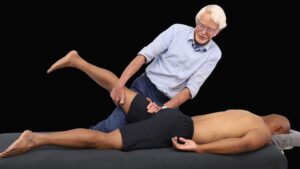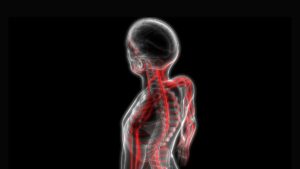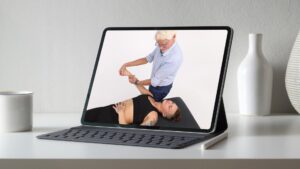Summary: Tight muscles create asymmetry and weak muscles lead to asymmetry in both the myofascial and skeletal systems. Deep, intrinsic muscles and the bony foundation of the body are inseparable: What affects one always affects the other. Until the therapist develops a basic understanding of how deep tissue techniques affect mobility/stability in the bony framework, random deep tissue work is contraindicated. Massage and bodyworkers who focus on chronic pain and postural problems profit by studying spinal biomechanics and learning to focus therapeutic intent on both myofascial and spine-related (articular) structures.
Poor joint function and accompanying protective muscle spasm is commonly seen in clients dealing with long-term neck, upper-shoulder and arm pain. People who often hold a telephone with one shoulder frequently develop chronic unilateral hypertonicity in the levator scapula and splenius cervicis muscles. Because of their common attachments at the top three or four cervical transverse processes, unilateral contraction of these muscles sidebends and rotates the neck and elevates the shoulder to help secure the phone. Problems escalate as deep spinal “groove” muscles such as rotatores, multifidi, and intertransversarii react to unilateral sustained hypercontraction. When overstimulated, these fibrotic little rascals are notorious for locking facets closed on the ipsilateral side and open on the contralateral side.
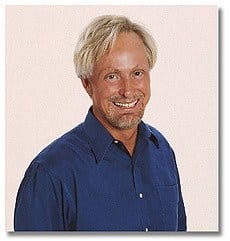
Sensitive joint mechanoreceptors respond to sustained torsional loading by flooding the spinal cord with noxious afferent messages that could cause the brain to further shorten these spinal rotators. Repeated exposure to compressive forces from prolonged unilateral neck sidebending also leads to joint cartilage degradation, which, in turn, leads to adhesive tissue build-up at the cervicothoracic junction, i.e., Dowager’s Hump.
Conceptualize for a moment the forward-drawn head also being pulled into right sidebending and right rotation due to combined hypercontraction in the levator and splenius cervicis muscles. As the client begins to raise her head from a flexed to extended position, the facets on the right glide down on their inferior neighbor as they should. But the right sidebent neck alters vertebral tracking causing the left-sided facets to “jam” as the head and neck attempt backward bending, ie T3, cannot go back into proper closed position on T4. Because the T3 joint on the left is unable to close properly, it forces the T3 transverse processes to rotate right.
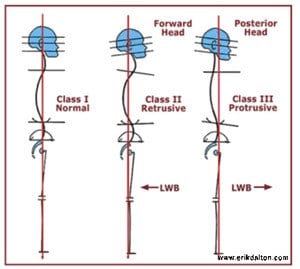
To compensate, the T3 rib on the right is forced into external rotation – Now the nagging pain begins. Lengthy irritation allows this “dynamic duo” (vertebra/rib fixation) to feed off each other, creating reflexogenic inhibition in the surrounding paravertebral muscles, including the rhomboids and trapezius muscles. Retraining exercises to strengthen the weakened lower shoulder stabilizer muscles to help resist the powerful pull of the massive pectorals are useless until both joint fixations are treated. Between-the-blade pain (dual fixation) is one of the longest lasting and most irritating joint-related problems our clients will ever experience.
To remedy this distressful situation, the fascia of splenius cervicis, levator scapula and anterior scalenes on the right must first be lengthened.
The therapist can use fingers or thumb to palpate the lamina groove bilaterally scanning in an inferior direction until the bony knot on the right at T3 is palpated. Using soft, sustained anterior/inferior pressure, the client is instructed to inhale to a count of five, while carefully attempting to extend and left-rotate her head against the sustained isometric resistance from the therapist thumb.
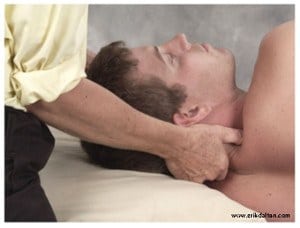
When the bony knot pushes back against the therapists resistance, a powerful Golgi tendon organ release is transferred through the transverse process to the adjoining spinal rotator muscles, creating increased capsular flexibility and subsequent joint decompression.
As the client exhales and relaxes, a post-isometric relaxation result further softens the muscles and joint capsules. Pressure from the therapist finger slowly de-rotates T3 and the improved tracking allows the T3 facets on the left to slide smoothly down on T4.
If immediate softening is palpated in the surrounding spinal muscles following this technique, then the therapist has done her or his duty. Always notice to see if the rib on the left has corrected itself by lightly scanning the rib shafts with soft fingertips, superior to inferior, feeling for a bump at about T3. If a slightly bulging rib shaft is palpated, the rib is still stuck in internal rotation. With fingers or thumbs, simply release the intercostal muscles above the dysfunctional rib in a medial to lateral direction. Then apply the same basic procedure as above to align the costotransverse rib joint. Finish off the routine with a soft elbow dragging down the groove as the client extends and relaxes the head and neck.
Read more at www.erikdalton.com
Erik Dalton, Ph.D., Certified Advanced Rolfer, began the Freedom From Pain Institute and created Myoskeletal Alignment Techniques to share his passion for massage, Rolfing, and manipulative osteopathy. Go to the Erik Dalton website for information on workshops, conferences, and CE home study courses.







